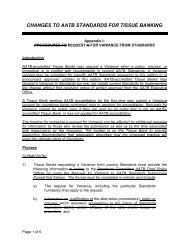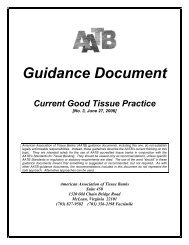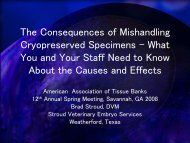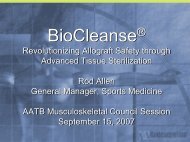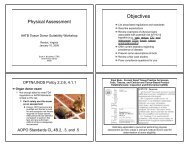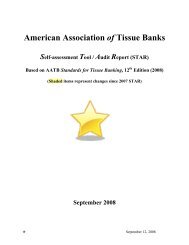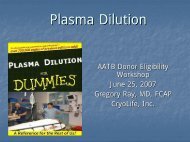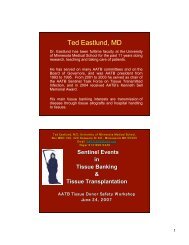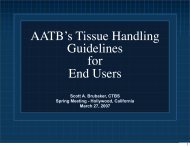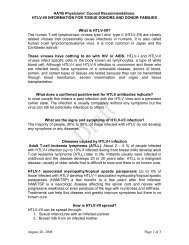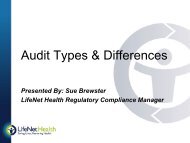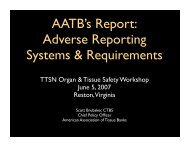Guidance Document, No. 5 - American Association of Tissue Banks
Guidance Document, No. 5 - American Association of Tissue Banks
Guidance Document, No. 5 - American Association of Tissue Banks
You also want an ePaper? Increase the reach of your titles
YUMPU automatically turns print PDFs into web optimized ePapers that Google loves.
Interim <strong>Guidance</strong><br />
<strong>Document</strong><br />
Standard K2.210<br />
Pre-Sterilization/<br />
Pre-Disinfection Cultures<br />
[<strong>No</strong>. 5, January 4, 2011]<br />
<strong>American</strong> <strong>Association</strong> <strong>of</strong> <strong>Tissue</strong> <strong>Banks</strong>’ (AATB) guidance documents, including this one, do not establish legally<br />
enforceable responsibilities. Instead, these guidelines describe the AATB’s current thinking on this topic. They are<br />
intended solely for the use <strong>of</strong> AATB accredited tissue banks in conjunction with the AATB’s Standards for <strong>Tissue</strong><br />
Banking. They should be viewed only as recommendations, unless specific AATB Standards or regulatory or<br />
statutory requirements are cited. The use <strong>of</strong> the word “should” in these guidance documents means that something<br />
is suggested or recommended, but not required. As with other AATB guidance documents, the recommendations<br />
included in this document do not represent the sole approach. Alternative approaches can be used.<br />
<strong>American</strong> <strong>Association</strong> <strong>of</strong> <strong>Tissue</strong> <strong>Banks</strong><br />
1320 Old Chain Bridge Road<br />
Suite 450<br />
McLean, Virginia 22101<br />
(703) 827-9582 (703) 356-2198 Facsimile
Additional copies <strong>of</strong> this <strong>Guidance</strong> <strong>Document</strong> are available from the AATB <strong>of</strong>fice. In addition,<br />
comments on this document may be submitted at any time to the AATB. The <strong>Association</strong> will<br />
review any comments received and revise the <strong>Guidance</strong> <strong>Document</strong> as appropriate. All requests<br />
and comments should be addressed to:<br />
<strong>American</strong> <strong>Association</strong> <strong>of</strong> <strong>Tissue</strong> <strong>Banks</strong><br />
Suite 450<br />
1320 Old Chain Bridge Road<br />
McLean, Virginia 22101<br />
www.aatb.org<br />
For questions on the content <strong>of</strong> the document, please contact the AATB at:<br />
(703) 827-9582 or (703) 356-2198 (Fax)<br />
Mention <strong>of</strong> specific products or equipment in this AATB publication does not represent an<br />
endorsement <strong>of</strong> such products or equipment by the AATB, nor does it necessarily indicate a<br />
preference for those products or equipment over other similar competitive products or<br />
equipment. Any forms and/or procedures in this document are examples. The AATB does not<br />
imply or guarantee that the materials meet federal, state, or other applicable requirements. It is<br />
incumbent on the reader who intends to use any information, forms, policies, or procedures<br />
contained in this publication to evaluate such materials for use in light <strong>of</strong> particular<br />
circumstances associated with his or her facility.<br />
Efforts are made to have publications <strong>of</strong> the AATB consistent in regard to acceptable practices.<br />
However, for several reasons, they may not be. As new developments in the practice <strong>of</strong> tissue<br />
banking occur, changes may be recommended to the Standards for <strong>Tissue</strong> Banking. It is not<br />
possible, however, to revise each publication at the time such a change is adopted. Thus, it is<br />
essential that the most recent edition <strong>of</strong> the Standards be consulted as a reference in regard to<br />
current acceptable practices. The publication <strong>of</strong> this guidance document does not constitute an<br />
endorsement by the AATB <strong>of</strong> these recommendations as the only acceptable practice. The<br />
AATB expressly disclaims any liability arising from any inaccuracy or misstatement herein.<br />
Page 2 <strong>of</strong> 6
TABLE OF CONTENTS<br />
I. Introduction 4<br />
II. Sampling Methods 4<br />
III. Test Methods 5<br />
IV. Summary 5<br />
V. References 6<br />
Page 3 <strong>of</strong> 6
AATB INTERIM GUIDANCE DOCUMENT<br />
Standard K2.210 Pre-Sterilization/Pre-Disinfection Cultures<br />
I. INTRODUCTION<br />
AATB Standard K2.210 requires that appropriate pre-sterilization/pre-disinfection cultures from<br />
each donor shall be obtained and evaluated. This Interim <strong>Guidance</strong> <strong>Document</strong> is designed to<br />
provide basic information to assist tissue banks with the development <strong>of</strong> generally accepted presterilization/pre-disinfection<br />
culture methods and sampling plans. However, please note that the<br />
methods summarized in this document are only a few limited examples <strong>of</strong> sampling strategies<br />
and culture methods tissue banks may adopt. In the future, the AATB will issue more detailed<br />
guidance related to this subject.<br />
AATB Standard E1.700 requires that in-process control and testing be established. The outcome<br />
<strong>of</strong> a disinfection or sterilization process is related to the capability <strong>of</strong> that process to reduce or<br />
eliminate an expected level and mix <strong>of</strong> microorganisms on the particular tissue type being<br />
exposed to the process. If pre-sterilization/pre-disinfection microbiological load exceeds what<br />
the process has been validated to remove or inactivate, there is a lack <strong>of</strong> assurance that the<br />
process will result in the reduction or removal <strong>of</strong> microorganisms to acceptable numbers. Presterilization/pre-disinfection<br />
microbiological cultures play a critical role in ensuring that the<br />
validated process capability will not be exceeded.<br />
II. SAMPLING METHODS<br />
Pre-sterilization/pre-disinfection samples may be recovered at the time <strong>of</strong> tissue recovery prior to<br />
exposing the tissue to antibiotics, disinfecting chemicals, or sterilizing agents. Samples may also<br />
be obtained at the processing facility provided tissues were not exposed to<br />
disinfection/sterilization agents prior to sampling. Samples may be collected from each<br />
individual tissue or may be collected in accordance with a sampling strategy to represent all the<br />
tissues received from a particular donor.<br />
Indirect or direct sampling methods may be used to obtain pre-sterilization/pre-disinfection<br />
culture test samples. Indirect sampling is usually accomplished by either a swab or a fluid<br />
extraction method. In the swab method, samples <strong>of</strong> individual tissues are tested by swabbing the<br />
surface <strong>of</strong> each tissue and placing the swab into growth medium followed by incubation and<br />
reading the samples as positive or negative for microbial growth. Swab testing <strong>of</strong> individual<br />
tissues are <strong>of</strong>ten used to obtain pre-sterilization/pre-disinfection culture results for<br />
musculoskeletal tissue.<br />
In the fluid extraction method, individual samples or grouped samples are tested by immersing<br />
them in fluid and then testing the fluid. Often the fluids are filtered and the filter is placed onto<br />
growth medium followed by incubation and counting the number <strong>of</strong> colonies that have grown on<br />
the filter. Samples from fluid used to transport tissue can be used to obtain pre-sterilization/predisinfection<br />
culture results for cardiovascular and skin tissues.<br />
Page 4 <strong>of</strong> 6
Direct sampling is usually accomplished by placing samples <strong>of</strong> the tissue directly into growth<br />
media followed by incubation and reading <strong>of</strong> the samples qualitatively or quantitatively for<br />
microbial growth. Examples <strong>of</strong> direct sampling methods include testing <strong>of</strong> representative<br />
samples <strong>of</strong> tissue from various anatomical areas or samples from individual tissues recovered.<br />
<strong>Tissue</strong> banks may use a combination <strong>of</strong> indirect and direct sampling techniques depending upon<br />
the tissue type and disinfection/sterilization method.<br />
Both indirect and direct pre-sterilization/pre-disinfection sampling methods have inherent<br />
strengths and weaknesses. For example, swab and fluid indirect test methods are able to cover<br />
large exterior surface areas <strong>of</strong> the tissue and are able to test the actual tissues to be released for<br />
transplant. However, the organism recovery efficiency for swab and fluid tests is generally<br />
lower than the direct sample method. <strong>No</strong>te that the organism recovery efficiency is a<br />
determination <strong>of</strong> the ability <strong>of</strong> the test method to remove microorganisms from the tissue.<br />
Recovery efficiencies are generally performed by the microbiology testing laboratory using<br />
standard test methods as part <strong>of</strong> a test method validation protocol.<br />
III. TEST METHODS<br />
Qualitative microbiological test methods are used to detect the presence <strong>of</strong> viable<br />
microorganisms. They can only provide a growth or no growth result. Samples that are positive<br />
for growth shall have the organism identified to the genus, and, where appropriate, the species<br />
level (see K3.300 Microbiologic Subcultures). Pre-sterilization/pre-disinfection cultures using<br />
swabs are qualitative microbiological test methods. <strong>Tissue</strong> banks use these results to determine<br />
the acceptability <strong>of</strong> tissue for future processing.<br />
Quantitative microbiological test methods are used to determine the quantity and types <strong>of</strong><br />
organisms present. This bioburden approach <strong>of</strong>fers the advantage <strong>of</strong> quantifying the<br />
microbiological challenge to the disinfection or sterilization process. In certain circumstances<br />
establishing quantifiable bioburden, actual colony forming units per tissue, may be accomplished<br />
via fluid-extraction and filter-culturing techniques. Quantitative bioburden testing is a<br />
fundamental part <strong>of</strong> the validation <strong>of</strong> a disinfection or sterilization process; such testing is<br />
particularly important for irradiation sterilization validation.<br />
IV. SUMMARY<br />
Pre-sterilization/pre-disinfection microbiological cultures play a critical role in monitoring the<br />
microbial challenge to the disinfection or sterilization process to ensure that the process<br />
capability will not be exceeded. <strong>Tissue</strong>s can present unique testing challenges. Furthermore,<br />
some microorganisms are difficult to culture, so, if present at low levels, may not be detected<br />
through routine testing. <strong>Tissue</strong> banks should consider all relevant issues such as tissue type,<br />
potential microorganisms and sterilization/disinfection processes as they develop presterilization/pre-disinfection<br />
culture and sampling strategies used to represent all tissues received<br />
from a particular donor.<br />
Page 5 <strong>of</strong> 6
V. REFERENCES<br />
1. Current AATB Standards for <strong>Tissue</strong> Banking<br />
2. FDA/Centers for Disease Control and Prevention workshop entitled, “Processing Methods<br />
for Orthopedic, Cardiovascular, and Skin Allografts”, October 11-12, 2007<br />
(http://www.fda.gov/downloads/BiologicsBloodVaccines/NewsEvents/WorkshopsMeetings<br />
Conferences/TranscriptsMinutes/UCM054425.pdf) - accessed December 28, 2010<br />
3. Sterilization <strong>of</strong> health care products—Radiation—<strong>Guidance</strong> on sterilization <strong>of</strong> human tissuebased<br />
products, (TIR37:2007), Section 5.4.1. <strong>Association</strong> for the Advancement <strong>of</strong> Medical<br />
Instrumentation (AAMI)<br />
Page 6 <strong>of</strong> 6



